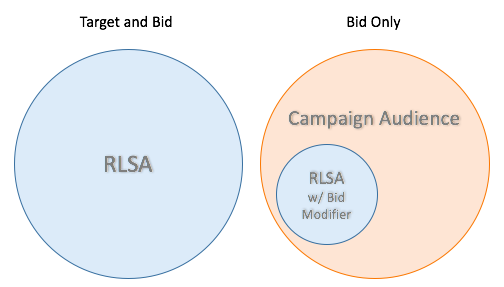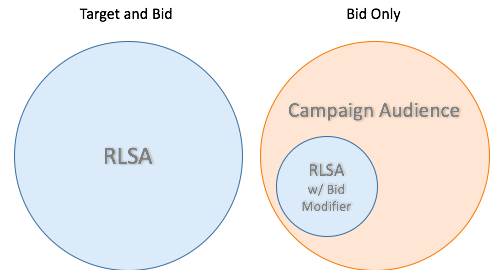— November 22, 2017
As many as 98% of website visitors don’t convert on their first visit. There are many ways that online marketers work to improve these initial conversion rates—employing effective ways to interact with your visitors to eventually convert them into customers is a crucial component of a comprehensive strategy.
One of these ways is to take advantage of remarketing lists for search ads (RLSA), which is a great way to re-engage potential customers with the added benefit of search intent signals. This post highlights some of the best ways to incorporate them into your search strategy.
Understand and Utilize the Different RLSA Options to Their Strengths
Before you get started, it’s important to understand the differences and the two basic options for RLSA and how to use them appropriately.

Target and Bid
The first is Target and Bid. This option allows you to set a defined audience that your ads will be delivered to, with the ability to set individual bids on specific keywords with that audience in mind. The main benefit of this approach is that it allows you to spend your budget more efficiently in generic, top-of-funnel campaigns without requiring as much investment as it otherwise would to find success in them.
Suppose you’ve homed in on a specific audience segment that you know has a high propensity to convert. Now, you can bid on that audience for broader keywords without having to rely as much on the level of intent of those terms. This will also serve as a hedge against the fact that these keywords tend to be more competitive to rank for. It also, of course, allows you to tailor your ads more uniquely to that audience.
Bid Only
The other option is Bid Only. Unlike Target and Bid, this setting doesn’t restrict the audience for your ads. Instead, it allows you to use remarketing lists as an additional layer of bidding criteria—making it ideal for advertisers who want to keep their reach wide while being able to vary the degree of aggressiveness with bid modifiers, depending on the audience. This strategy is preferable for campaigns that are still in the process of building those remarketing lists.
Whichever setting makes the most sense depends on the campaign and goal. In general, the Target and Bid setting is the more conservative option when you’re evaluating the performance of generic queries. The Bid Only setting is generally better as an added degree of optimization for campaigns that are already performing well.

Use RLSA for Shopping Campaigns
If you’re not doing so already, consider this standard practice moving forward, as it’s a powerful way to get previous site visitors into your funnel. If they viewed products and left before purchasing, use product listing ads when they perform a relevant search later on. This serves as a visual reminder that can nudge them toward conversion. (And, make sure your PLAs are optimized for when they do.)
To create a tiered strategy based on likeliness to convert, set up audience lists to correspond to each point in your purchase funnel (e.g., All Visitors, Product Viewers, Cart Abandoners, etc.) and modify bids increasingly towards the bottom of the funnel.
Combine RLSA Targeting with Demographic Bidding
In case you missed it, Google AdWords now supports demographic bidding on the search network as of late 2016 (although Bing beat them to the punch). With the ability to set bid modifiers on gender and age ranges—which can be used to enhance your standard search campaigns—you can now combine the powers of remarketing, search intent, and demographic targeting. This of course allows you to narrow down your best-converting visitor profile even further based on your campaign and site analytics. (Pro tip: You can also use Facebook Insights to help identify demographic segments that perform the best and set bid modifiers accordingly.)
Digital & Social Articles on Business 2 Community
(110)






